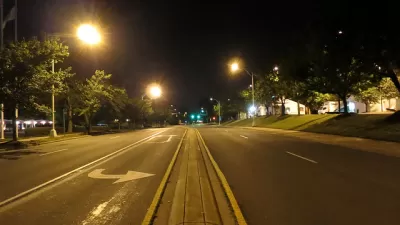Little Asphalt minimizes pavement in cities, towns, and suburbs so that real estate can be used for higher value purposes—such as buildings and people-centered activities.
I have written about the problems of Big Asphalt. The opposite is Little Asphalt, which can be described in three ways.
1) It’s an approach that minimizes pavement in cities, towns, and suburbs so that real estate can be used for higher value purposes—such as buildings and people-centered activities. Little asphalt disperses traffic rather than concentrates it. It eases automotive traffic through expanding opportunities for walking, bicycling, transit, and other ways to get around. It reduces impervious surfaces that create stormwater runoff.
2) It’s a place dominated by the character of the surroundings and activities rather than the pavement. Little Asphalt is a magnet for people, not cars. Automobiles are usually welcome—but only at speeds that do not threaten the safety of the people or the character of the place.
3) Little Asphalt represents the interests that benefit from such places—In this case, the communities themselves, the people who live and use these communities, and the landowners who will benefit from higher values created by Little Asphalt.
Little Asphalt recognizes that pavement itself is a big part of sprawl—not just houses spread out across the landscape, a car-oriented lifestyle, big box stores, and disinvestment in cities. Vast parts of America are over-paved in a relentless—and often futile—pursuit of frictionless driving. Highways slice through cities and downtown buildings are leveled in favor of parking lots. Most of the suburbs are not walkable because of excess paving since the middle of the 20th Century. Little Asphalt runs this process in reverse and is essential for creating more walkable, people-centered places.
FULL STORY: The Little Asphalt solution for sustainable, healthy communities

Planetizen Federal Action Tracker
A weekly monitor of how Trump’s orders and actions are impacting planners and planning in America.

Chicago’s Ghost Rails
Just beneath the surface of the modern city lie the remnants of its expansive early 20th-century streetcar system.

San Antonio and Austin are Fusing Into one Massive Megaregion
The region spanning the two central Texas cities is growing fast, posing challenges for local infrastructure and water supplies.

Since Zion's Shuttles Went Electric “The Smog is Gone”
Visitors to Zion National Park can enjoy the canyon via the nation’s first fully electric park shuttle system.

Trump Distributing DOT Safety Funds at 1/10 Rate of Biden
Funds for Safe Streets and other transportation safety and equity programs are being held up by administrative reviews and conflicts with the Trump administration’s priorities.

German Cities Subsidize Taxis for Women Amid Wave of Violence
Free or low-cost taxi rides can help women navigate cities more safely, but critics say the programs don't address the root causes of violence against women.
Urban Design for Planners 1: Software Tools
This six-course series explores essential urban design concepts using open source software and equips planners with the tools they need to participate fully in the urban design process.
Planning for Universal Design
Learn the tools for implementing Universal Design in planning regulations.
planning NEXT
Appalachian Highlands Housing Partners
Mpact (founded as Rail~Volution)
City of Camden Redevelopment Agency
City of Astoria
City of Portland
City of Laramie



























